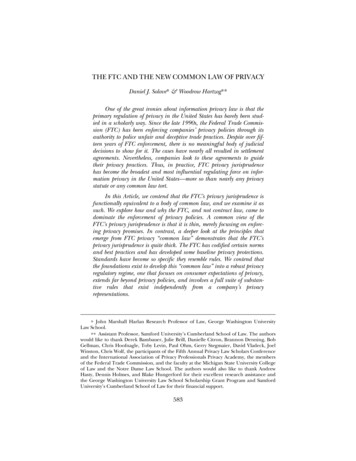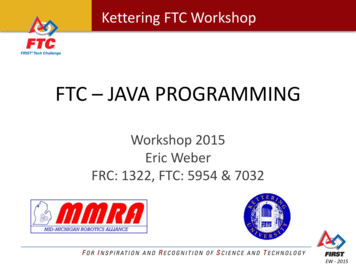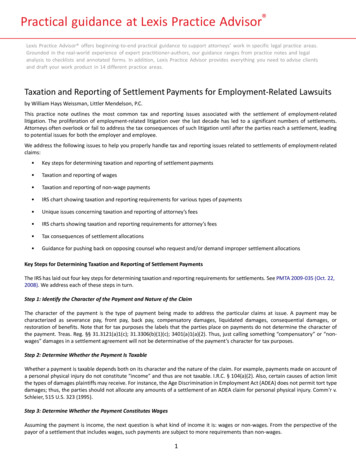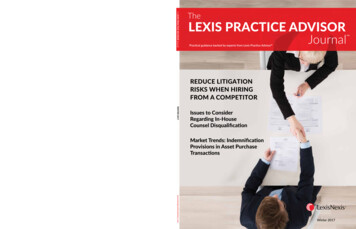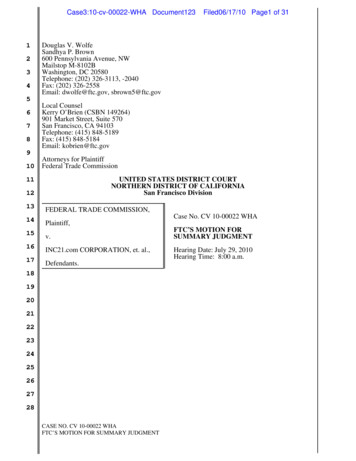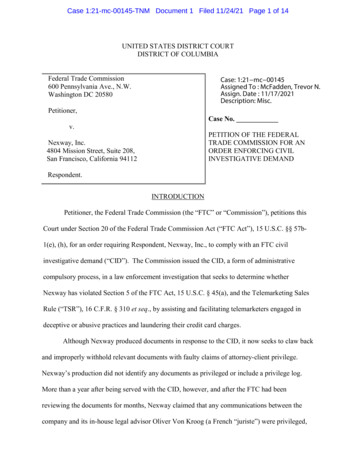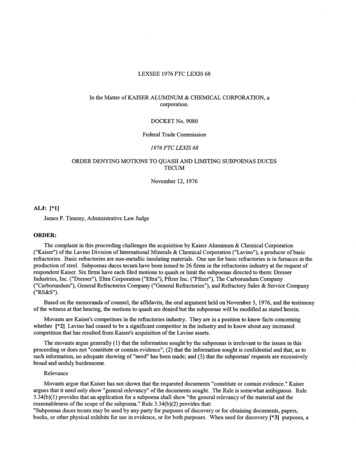
Transcription
LEXSEE 1976 FTC LEXIS 68In the Matter of KAISER ALUMINUM & CHEMICAL CORPORATION, acorporation.DOCKET No. 9080Federal Trade Commission1976 FTC LEXIS 68ORDER DENYING MOTIONS TO QUASH AND LIMITING SUBPOENAS DUCESTECUMNovember 12,1976ALJ: [*I]James P. Timony, Administrative Law JudgeORDER:The complaint in this proceeding challenges the acquisition by Kaiser Aluminum & Chemical Corporation("Kaiser") of the Lavino Division of International Minerals & Chemical Corporation ("Lavino"), a producer of basicrefractories. Basic refractories are non-metallic insulating materials. One use for basic refractories is in furnaces in theproduction of steel. Subpoenas duces tecum have been issued to 26 firms in the refractories industry at the request ofrespondent Kaiser. Six firms have each filed motions to quash or limit the subpoenas directed to them: DresserIndustries, Inc. ("Dresser"), Eltra Corporation ("Eltra"), Pfuer Inc. ("Pfizer"), The Carborundum Company("Carborundum"), General Refractories Company ("General Refractories"), and Refractory Sales & Service Company("RS&S1').Based on the memoranda of counsel, the affidavits, the oral argument held on November 3, 1976, and the testimonyof the witness at that hearing, the motions to quash are denied but the subpoenas will be modified as stated herein.Movants are Kaiser's competitors in the refractories industry. They are in a position to know facts concerningwhether 1'21 Lavino had ceased to be a significant competitor in the industry and to know about any increasedcompetition that has resulted from Kaiser's acquisition of the Lavino assets.The movants argue generally (1) that the information sought by the subpoenas is irrelevant to the issues in thisproceeding or does not "constitute or contain evidence"; (2) that the information sought is confidential and that, as tosuch information, no adequate showing of "need" has been made; and (3) that the subpoenas' requests are excessivelybroad and unduly burdensome.RelevanceMovants argue that Kaiser has not shown that the requested documents "constitute or contain evidence." Kaiserargues that it need only show "general relevancy" of the documents sought. The Rule is somewhat ambiguous. Rule3.34(b)(l) provides that an application for a subpoena shall show "the general relevancy of the material and thereasonableness of the scope of the subpoena." Rule 3.34(b)(2) provides that:"Subpoenas duces tecum may be used by any party for purposes of discovery or for obtaining documents, papers,books, or other physical e h b i t s for use in evidence, or for both purposes. When used for discovery [*3] purposes, a
1976 FTC LEXIS 68, *Page 2subpoena may require a person to produce and permit the inspection and copying of nonprivileged documents, papers,or other physical exhibits which constitute or contain evidence relevant to the subject matter involved and which are inthe possession, custody, or control of such persons."Movants argue that Rule 3.34(b)(2) requires that discovery subpoenas must call not only for generally relevantdocuments but also for those which constitute or contain evidence.The phrase "which constitute or contain evidence," as used in Rule 3.34(b)(2), apparently means no more than theword "relevant." Otherwise, while the Rule explicitly allows discovery subpoenas, only "evidence" could be gathered."The process of interpretation. misses its high function if a strict reading of a law results in the emasculation ordeletion of a provision which a less literal reading would preserve." Markam v. Cabell, 326 U.S. 404,409 (1945). Evenif the wording of the Rule were apparent, that meaning will not be applied if it would lead to absurd results. FTC v.Retail Credit Co., 515 F.2d 988,994-95 (D.C. Cir. 1975); FTC v. Tuttle, 244 F.2d 606, 614 (2d Cir. 1957), [*4] cert.denied, 354 U.S. 925.In my opinion, Commission Rule 3.34(b) allows discovery of generally relevant documents which may aid in thepreparation of respondent's defense even though they are inadrmssible as evidence. This is the scope of discovery underthe Federal Rules of Civil Procedure. Rule 26(b)(l); Moore's Federal Practice, Rules Pamphlet 620-21 (1975). nll Thepractice of the Commission has been to uphold subpoenas duces tecum upon a showing by any party that the requestedinformation is generally relevant to the issues raised by the pleadings. FTC v. Menzies, 145 F. Supp. 164, 170 (D. Md.1956), affd, 242 F.2d 81 (4th Cir. 1957), cert. denied, 353 U.S. 957; FTC v. U.S. Pipe & Foundry Co., 304 F. Supp.1254,1259 (D.D.C. 1959). Moreover, whether documents sought in discovery constitute or contain evidence cannot beresolved until the trial is under way. FTC v. Menzies, supra, 145 F. Supp. at 170. Movants' construction would havediscovery subpoenas usefid only during the trial. This awkward procedure was certainly not intended in Rule 3.34(b).n l l In United States v. Associated Merchandising Corp., 261 F. Supp. 553 (S.D.N.Y. 1966), the courtdiscerned a difference between an investigative subpoena and an adjudicative subpoena, whch at that time couldbe issued under the Commission Rules only for good cause. 261 F. Supp. at p. 558. In applying the rule,however, the court enforced the specification even where it was of doubthl relevance unless production wouldbe unduly burdensome. 261 F. Supp. at p. 561.Unlike the Federal Rules where the scope of depositions and subpoenas duces tecum used in discovery isthe same, under the Commission's Rules of Practice, the use of depositions is more restricted than the use ofsubpoenas duces tecum. Compare Commission Rules 3.33 and 3.34. [*5]The relevancy of the information sought is determined by laying the subpoena along side the defenses raised byKaiser's answer to the complaint. FTC v. U.S. Pipe & Foundry Co., 304 F. Supp. 1254, 1260 (D.D.C. 1969); cf. Adamv. FTC, 296 F.2d 861, 867 (8th Cir. 1961), cert. denied, 269 U.S. 864; Moore Business Forms, Inc. v. FTC, 307 F.2d188, 189 (1962). n21 Here, Kaiser's answer puts at issue the question of whether the markets alleged in the complaintconstitute appropriate or economically meaningful product categories in which to assess the efforts of the acquisition.Further, the answer contests whether the acquisition is likely to result in any substantial lessening of competition, andasserts (1) recent changes in the steel industry's demand for refractories, (2) the importance of a secure raw materialsupply, economies of scale, and research and development, and (3) competition in the refractories industry caused bythe purchasing power of steel companies. To prove these defenses, Kaiser states (opposition Memo, pp. 6-7) that itmust obtain such data as:n2/ For this reason, movants' argument that respondent's discovery should be limited to that obtained bycomplaint counsel is without merit. [*6]"(1) the identities, production levels, and market shares--and the changes in these factors over time as a result of thecontinuing technological changes in the industry--of the major refractories manufacturers and sellers; (2) the breakdownof each manufacturer's production among the product classes alleged by the Commission and into other categoriesmaking up the overall refractories industry; (3) the capabilities of existing refractories manufacturing facilities, theproducts they produce, and the corresponding cost and profit parameters; (4) the identities and purchasing practices ofthe major refractories purchasers; and (5) the industry perception, as indicated in business analyses, studies, andforecasts, of such matters as trends in market demand, competition, raw material supply, refractories technology, andthe effects of the acquisition."
1976 FTC LEXIS 68, *Page 3All of the specifications of the subpoenas bear a general relevancy to the defenses raised by respondent Kaiser. n3/Movants are all competitors of respondent Kaiser in the production and sale of refractories. Information in the files ofcompeting companies is frequently crucial in proceedings such as thls one. In FTC v. [*7] Bowman, 149 F. Supp. 624,628 (N.D. Ill. 1957), affd, 248 F.2d 456 (7th Cir.), the court emphasized the relevance of the kind of data sought here asfollows:n3/ RS&S, a producer of refractories, argues that it does not produce basic refractories and does not supplyrefractories for use in furnaces in malung steel. RS&S did, however, until two years ago advertise and sell asimilar product, the ingredients for which it would obtain from other f m and "mix" for a customer. Similarly,one of P f e r ' sdivisions, "MPM," ceased producing refractories in 1972. Kaiser, however, is not limited inpreparing its defense to the markets alleged in the complaint. And information concerning other refractoriesproducts is therefore relevant to the issues in this proceeding."In a proceeding under the anti-merger provisions of the Clayton Act, the share of the market affected by the mergerand the effect on competitors engaged in the same line of commerce are crucial inquiries. The proceeding would becrippled if neither the Commission nor the party charged could produce by compulsory process the essential industrydata."See also Covey Oil Co. v. Continental Oil Co., [*a] 340 F.2d 993,998 (10th Cir. 1965), cert. denied, 389 U.S.1110; FTC v. Tuttle, 244 F.2d 605, 609,614 (2d Cir. 1957), cert. denied, 354 U.S. 925; United States v. AmericanOptical Co., 39 F.R.D. 580,586 (N.D. Cal. 1966); United States v. Lever Bros. Co., 193 F. Supp. 254,257 (S.D.N.Y.1961).Movants argue that the time period covered by the subpoenas is excessive. Proof of the long-term trends assertedby Kaiser will require reliance on industry statistics showing production levels, sales and other matters over a number ofyears. And Kaiser's demands for non-statistical data in studies and analyses of the industry are crietical to proof ofindustry trends and probable future effects of the acquisition. Such industry trends are relevant proof in a proceedingsuch as this one. United States v. General Dynamics Corp., 415 U.S. 486,498, 501, 504-06 (1974). While the timeperiod in some of the specifications is extensive (10 years), the courts have ordered production of such proof whererelevant to issues raised in the pleadings such as the trends asserted here. Adam v. FTC, 296 F.2d 861,867-68 (8thCir. 1962), cert. [*9] denied, 369 U.S. 864; United States v. IBM, 66 F.R.D. 481,483 (S.D.N.Y. 1975); cf. L. G.Balfour Company v. FTC, 1964 CCH Trade Cases, p. 79,221 (E.D. Va. 1964) (consent judgment). n4/n4/ Movants argue that data available from the United States Bureau of Census should be used to showtrends in the refractories industry, and that individual company data should not be required. Kaiser points out,however, that the Census statistics are insufficient. For example, they report shipments, not sales. They do notpermit a showing of the changes, if any, of concentration in the industry. They do not reflect how much of thetotal consists of shipments for use in foreign countries. And the categories of refractories have apparentlychanged over the years relevant to respondent's trend defense.ConfidentialityEach of the movants argues that the documents requested need not be produced because they are "confidential."The fact that information sought by a subpoena may be confidential does not excuse compliance. n5/ It is wellestablished that confidential information of the type sought enjoys no exemption from mandatory production indiscovery [*lo] proceedings before admmistrative agencies or courts. Covey v. Continental Oil Co., 340 F.2d 993,999(10th Cir. 1965), cert. denied, 380 U.S. 1110; FTC v. Tuttle, 244 F.2d 605,607,609,616 (2d Cir. 1957), cert. denied,354 U.S. 925. Where the provisions of the protective order prevent dissemination of confidential information tocompetitors and where the information sought is relevant to the issues in the proceeding, the courts have dismissedobjections to subpoenas duces tecum based on the confidentiality of the requested information. Covey Oil Co. v.Continental Oil Co., 340 F.2d at 999; Menzies v. FTC, 242 F.2d 81,84 (4th Cir.), cert. denied, 353 U.S. 957 (1957);Graber Mfg. Co. v. Dixon, 223 F. Supp. 1020 (D.D.C. 1963); Hunter v. International Systems & Controls Corp., 51F.R.D. 25 1,255 (W.D. Mo. 1970).
1976 FTC LEXIS 68, *Page 4n5/ General Refractories' assertion that the subpoena is unconstitutional in requiring the production ofconfidential commercial information is not persuasive. FTC v. Tuttle, 244 F.2d 605, 609 (2d Cir. 1957), Iced.denied, 354 U.S. 925.Furthermore, a showing of general [*I11 relevance is sufficient to justify production of documents containingconfidential business information and no further showing of "need" is necessary. See, e.g., FTC v. U.S. Pipe & FoundryCo., 304 F. Supp. 1254, 1256, 1259-60 (D.D.C. 1969); FTC v. Menzies, 145 F. Supp. 164, 170-71 (D. Md.), affd 242F.2d 81 (4th Cir.), cert. denied, 353 U.S. 957 (1957). See also Olympic Refining Co. v. Carter, 332 F.2d 260 (9th Cir.1964); Covey Oil Co. v. Continental Oil Co., supra; Hunter v. International Systems & Controls Corp., supra; and seeEstate of Le Baron v. Rohm & Haas Co., 441 F.2d 575 (9th Cir. 1971). While some courts have required that ashowing of "need" should accompany a showing of "general relevancy" to support mandatory production of tradesecrets, these cases involved deleted provisions of the former discovery rules requiring a showing of "good cause" n6/or unusual facts involving great burden on the responding company. Zenith Radio Corp. v. Radio Corp. of America,106 F. Supp. 561,564 (D. Del. 1952); Papercraft Corp. v. FTC, 472 F.2d 927, 930 (7th Cir. 1973); United States [*12]v. American Optical Co., 39 F.R.D. 580 (N.D. Cal. 1966).n6/ See 4A Moore's Federal Practice, 51968.534.01[8], 34.08 (1975). The Commission rule was changed inA protective order was entered in this proceeding on July 29, 1976. This order provides appropriate procedures foridentification of "confidential information" and narrowly restricts dissemination of such data. Movants could protectthe confidentiality of the subpoenaed information pursuant to the terms of h s order, or negotiate additional protectionsin the terms of the order. n7/n7/ Two of the subpoenaed companies have received a modification of the protective order to exclude insidecounsel from access to certain documents.At the hearing on the motions to quash held on November 3, 1976, the adrmnistrative law judge made itclear that any reasonable request for a modification of the protive order would be granted. Examples of suchmodifications include, for example, having the documents returned to the subpoenaed companies at theconclusion of the case; providing that the documents could be used for this case only; limiting access to thedocuments to trial counsel; providing reasonable notice to the subpoenaed company prior to disclosure to anyother agency, Congress, or a court, and before the documents are offered in evidence at the trial in this case; andgranting an extension of time for compliance with the subpoena to allow a particular specification of thedocuments for whch protection is needed (e.g., Motion by Carborundum Company to Extend Time, filedOctober 14, 1976). [*I31Movants argue that any protective order issued by an administrative law judge would not be adequate because: (1)the Commission, on its own motion and without notice, might make the information available to Congress or anotheragency or the public; (2) the information might be made public by a court in a Freedom of Information Act suit; (3) theinformation might be "leaked" in an unauthorized release. These arguments are not persuasive. The Commission hasrecognized that it must accord confidential treatment to documents tendered under protective orders even where theorders are improper. Hood & Sons, Inc., 58 F.T.C. 1184 1190 (1961). Furthermore, once the documents sought by thesubpoenas are covered by the protective order, and until they are offered in evidence, they will be kept in the files oftrial counsel representing Kaiser, and Commission personnel will have access to them only for the purposes related tothe litigation of this case. Any in camera order entered during the trial herein will provide reasonable notice before thedocuments are released. Moreover, the Freedom of Information Act specifically exempts from disclosure "trade secretsand commercial or [*I41 financial information obtained fiom a person and privileged or confidential," 5 U.S.C. 5552(b)(4), and a possibility of a court-imposed release under that statute is unrealistic. And, while a "leak" could occur,the possibility is hypothetical and does not overcome the presumption of the regularity of adrmnistrative action. Cf.Md.-Nat'l Park & Planning Comm. v. Lynn, 514 F.2d 829,830 (D.C. Cir. 1975).Movants suggest the application of a Mississippi River protective order, whereby the individual company data isgiven to an outside consultant who aggregates it, presenting industry statistics without disclosure of individual companydata. This argument will be considered here. Cf. FTC v. Crowther, 430 F.2d 5 10 (D.C. Cir. 1970). T h s procedure isinappropriate for two reasons. First, since many of the subpoenaed parties have complied, they could probably identify
1976 FTC LEXIS 68, *Page 5individual company data from a Mississippi River compilation using "subtractive techniques," the data on hand, andtheir general industry knowledge. Second, the economic evidence Kaiser intends to present in defense will requirecorrelation of sales data, trends, profitability figures, [*I51 plant capacity, and projections on an individual producerbasis, and Mississippi River treatment would not provide a mechanism for such evidence.Movants argue that they are not parties to the admnistrative proceeding and are being asked to disclose what theyconsider important information. However, in United States v. American Optical Co., 39 F.R.D. 580,586 (N.D. Cal.1966), the court held that defendants were entitled to production by competitors of documents showing, inter alia, salesin units and dollars. The court said:"In cases such as thls, the risk of competitive injury to third parties, and the seriousness of such potential injury, must bebalanced against the need for the information in the preparation of the defense. Inconvenience to third parties may beoutweighed by the public interest in seelung the truth in every litigated case.See also, FTC v. Tuttle, 244 F.2d 605,609 (2d Cir. 1957), cert. denied, 354 U.S. 925; and United States v. LeverBrothers Co., 193 F. Supp. 254,257 (S.D.N.Y. 1961).The fact that information sought by the subpoenas involves sensitive, financial and trade data does not limit the[*I61 power to obtain it. FTC v. Tuttle, 244 F.2d at 616 (information relating to sales in dollars and units of variousitems); FTC v. U.S. Pipe & Foundry, 304 F. Supp. 1254 (D.D.C. 1969) (documents showing prices, sales, productioncosts, and profit and loss); United States v. American Optical Company, 39 F.R.D. 580 (N.D. Cal. 1966) (informationconcerning sales statistics, profit and loss and balance sheets); FTC v. Green, 252 F. Supp. 153 (S.D.N.Y. 1966)(breakdown of cost data by plants and categories); Singer Mfg. Co. v. Brother International Corp., 191 F. Supp. 322(S.D.N.Y. 1960) (sales and price data); In the Matter of Dependable Merchandise Corp., 14 F.R.D. 257 (S.D.N.Y. 1953)(mformation concerning suppliers); Caldwell-clements, Inc. v. McGraw-Hill Publishng Co., Inc., 12 F.R.D. 531(S.D.N.Y. 1952) (cost information). The court in Service Liquor Distributors v. Calvert Distillers Corp., 16 F.R.D. 507,509 (S.D.N.Y. 1954), said:". [In] an action under the antitrust laws, based upon the alleged abuse of competition, a competitor's business records,where good cause has been shown, are not only not immune from [*I71 inquiry, but they are precisely the source of themost relevant evidence."Most of the other f m in the refractories industry have chosen to comply with the subpoenas directed to them. InUnited States v. Aluminum Co. of America, 193 F. Supp. 249 (N.D.N.Y. 1960), a suit alleging violation of Section 7 ofthe Clayton Act, disclosure of production and sales figures had been sought from a number of the defendant'scompetitors and the court recognized that the fact that not all of the competitors objected to the disclosure of theinformation is some indication that the harm resulting from disclosure is minimal. 193 F. Supp. at p. 250. See also,FCC v. Schreiber, 381 U S . 279, 298-99 (1965); and United States v. American Optical Co., 39 F.R.D. 580,587 (N.D.Cal. 1966).Breadth and BurdenMovants claim that the subpoenas are invalid because their specifications are excessively broad and becausecompliance would impose cost, time and manpower burdens. Inspection of the subpoenas themselves shows that thespecifications are clearly drawn so as to identify the categories of documents relevant to the issues in this proceeding. Amore specific identification [*I81 of documents for production would require familiarity with the particular documentsin movants' files. Several of the specifications expressly indicate that summary statements of the requested data will beacceptable in place of the underlying documents.The courts have upheld and enforced subpoenas duces tecum with specifications drawn in terms similar to thoseemployed here. Genuine Parts Co. v. FTC, 445 F.2d 1382, 1389-90 (5th Cir. 1971); FTC v. St. Regis Paper Co., 304F.2d 731,732,733 (7th Cir. 1962); FTC v. Bowman, 149 F. Supp. 624, 626 (N.D. Ill.), affd, 248 F.2d 456 (7th Cir.1957).Several movants assert that the subpoenas are oppressive and burdensome. T h general,sunsupported claim is notpersuasive. Even where a subpoenaed third party adequately demonstrates that compliance with a subpoena will imposea substantial degree of burden, inconvenience, and cost, that will not excuse producing information that appearsgenerally relevant to the issues in the proceeding. United States v. Morton Salt Co., 338 U S . 632, 653-54 (1950); FTCv. Standard American, Inc., 306 F.2d 231,235 (3d Cir. 1962). n8/ Furthermore, [*I91 Kaiser has negotiatedreasonable modifications designed to alleviate these difficulties and has offered to do so with movants.
Page 61976 FTC LEXIS 68, *n8/ RS&S argues the burdensomeness of the subpoena even though, of 16 refractories producers servedwith identical sixspecification subpoenas, only RS&S has moved to quash. See United States v. Aluminum Co.of America, supra. Further, five of the six specifications allow RS&S to provide schedules rather thandocuments and the sixth calls for all sales, advertising, promotional and instructional documents sent tocustomers concerning the applications of refractories products. That specification will be modified to requireRS&S to provide representative examples of such documents.The modifications of the specifications made in h s order and memorandum should substantially reduce theburden described in the affidavits attached to the motions of Eltra and Pfuer.Several movants have argued that the size and complexity of their businesses will result in large costs in complyingwith the subpoenas. In this regard, Judge Weinfeld noted in Application of Radio Corp. of America, 13 F.R.D. 167,172(S.D.N.Y. 1952):"Inconvenience [*20] is relative to size. Any witness who is subpoenaed suffers inconvenience. An individualoperating a small business, for example, or a corporation operated by a sole shareholder, may suffer, in likecircumstances more inconvenience than [a major corporation] with. thousands of employees. But this inconvenience.is part of the price we pay to secure. the enforcement of our laws."See also United States v. IBM, 62 F.R.D. 507,510 (S.D.N.Y. 1974); Blank v. Talley Indus., Inc., 54 F.R.D. 627(S.D.N.Y. 1972).Several movants have requested that their costs incurred in complying with the subpoenas be reimbursed. Kaiserhas agreed to inspect the documents at the place of business of the movant and to bear the cost of copying. Courts haverequired reimbursement of the costs for search in civil suits between private companies where a third party wascomplying with the subpoena. Celanese Corp. v. E. I. duPont de Nemours & Co., 58 F.R.D. 606,612 (D. Del. 1973;Collins and Aikman Corp. v. v. J. P. Stevens & Co., 5 1 F.R.D. 2 19,221 (D.S.C. 1971). Where the public interest isinvolved, however, and where the nonparty is in the industry in whch alleged [*21] acts occurred, the nonparty has aninterest in the litigation and would be affected by the judgment. There, only the cost of copying need be reimbursed.United States v. IBM, 62 F.R.D. 507,510, and 526,529 (S.D.N.Y. 1974); FTC v. Ace Books, Inc., 11 Plke and Fisher,Ad. Law 2d 943,944 (S.D.N.Y. 1961).Particular SpecificationsIn addition to moving broadly to quash or limit the subpoenas in their entirety, most of the movants havealternatively moved to quash or limit particular specifications. Movants' arguments about each specification will nowbe considered.Specification 1Specification 1 of the subpoenas provides as follows:" 1. *Provide documents sufficient to indicate the volume and dollar amount of your sales of refractories for each yearbeginning with 1967 and for the first six months of 1976, divided by seven digit Standard Industrial Classificationcode." n9/n9/ The subpoenas provide that where a specification is preceded by an asterisk, schedules or tabulationsmay be produced in lieu of responsive documents.T h s specification seeks information on the physical volume and dollar amount of movants' sales of refractories.[*22] The movants attack the time period for whch the information is sought, Pfuer, Eltra and Carborundum claimingthat data earlier than 1971 is irrelevant. One of Kaiser's defenses is that the refractories industry is undergoing a changeas a result of technological change in the steel industry and that only with evidence of sales over a period of timesufficient to reflect the technological change--and sufficient to allow the effects of cycles and short-term fluctuations inthe demand for steel to be separated out--can the alleged market shares be put in their proper perspective. Further,Kaiser argues that the sales trends to be developed with Specification 1 data are also essential to an understanding ofhow and why Lavino lost its independent competitive significance because of changing steel industry technology.Whle it will produce such data back to 1971, P f e arguesrthat the search of its files prior to 1971 is particularlyburdensome since they are stored unsystematically in warehouses located throughout the country and, further, that thedata is unreliable since it was not cross-checked as such sales data is now. Kaiser has stated its willingness to
1976 FTC LEXIS 68, *Page 7accommodate the [*23] subpoenaed companies as to their manner of record keeping, in order to minimize the burden ofcomplying with the subpoena. United States v. American Optical Co., 39 F.R.D. 580, 587 (N.D. Cal. 1966). Pfizer, ofcourse, cannot produce records if they do not exist. Nor can it compile reports which require data from records whlchdo not exist. Genuine Parts v. FTC, 313 F. Supp. 855, 857 (N.D. Ga. 1970), affd, 445 F.2d 1382 (5th Cir. 1971). Onthe other hand, the absence of compilations of information does not excuse the production of underlying records whchwould provide the requested information. United States v. IBM, 66 F.R.D. 187, 188 (S.D.N.Y. 1974).Specification 2Specification 2 of the subpoenas provides as follows:"2. * Provide documents sufficient to indicate separately for each basic refractories product sold by you the volume anddollar amount of your sales for each year beginning with 1967 and for the first six months of 1976."Specification 2 seeks detailed information on movants' sales of "basic" refractories, the refractories alleged by thecomplaint to constitute the product market in which the effects of the acquisition are [*24] to be considered. Pfuerargues that since the colplaint alleges that "basic" refractories constitute a relevant product market, informationregarding individual products within that market is irrelevant. Kaiser has not admitted that "basic" refractoriesconstitute a relevant product market, and Kaiser is entitled to obtain data to test that alleged market, as well as thealleged subrnarkets.Pfizer also argues that, while it has the original invoices, it does not maintain volume and sales data for each of its500 individual trademark products, and has only such data for general trademark groupings for the 1967-1971 period.P f e arguesrthat the alternative of turning over underlying documents to Kaiser would be equally burdensome since itwould involve "turning over thousands of invoices located in dead storage in Old Bridge, New Jersey." The absence ofcompilations does not excuse the production of the underlying records, see Specification 1, and' aiser'swillingness toaccommodate, supra, should reduce the burden at Old Bridge.Specification 3Specification 3 of the subpoenas provides as follows:"3. * Provide documents sufficient to indicate for each refractories [*25] manufacturing facility owned or operated byyou the refractories products which are or have been produced at the facility and the yearly manufacturing capacity ofthe plant for each such product."Pfuer argues that, while it could provide information on its total plant capacity based on reasonable assumptionsregarding product mix, it cannot provide it on a plant basis. Pfuer states that it manufactures 500 products; that thecapacity of each of its plants depends on which products are being produced at the time; and that the product mix is in aconstant state of flux. The absence of compilations does not excuse the production of underlying records, supra; butPfizer cannot produce what it does not have, see Specification 1. (The failure to make such estimates now, however,may lead to further
1976 FTC LEXIS 68 ORDER DENYING MOTIONS TO QUASH AND LIMITING SUBPOENAS DUCES TECUM November 12,1976 ALJ: [*I] . whch at that time could be issued under the Commission Rules only for good cause. 261 F. Supp. at p. 558. . of such matters as trends in market demand, competition, raw material supply, refractories technology, and .

